HTC VX smartphone User Manual Book VOX HTC English Manual indb
HTC Corporation smartphone Book VOX HTC English Manual indb
HTC >
Contents
- 1. User Manual 1
- 2. User Manual 2
- 3. Manual Revised 0710
- 4. User Manual Revised 0710 2
User Manual Revised 0710 2

Chapter 7
Working with Company E-mails
and Meeting Appointments
7.1 Synchronizing Your Phone with
Your Company E-mail Server
7.2 Working with Company E-mails
7.3 Managing Meeting Requests
7.4 Finding Contacts in the
Company Directory
7.5 E-mail Security
102 Working with Company E-mails and Meeting Appointments
7.1 Synchronizing Your Phone with Your Company
E-mail Server
Synchronize your phone with your company’s Microsoft Exchange Server
to keep you connected with your e-mails, contacts, calendar, and other
information.
Set up a company e-mail server connection
Use your phone to access your company e-mails by setting up an Exchange
Server connection. You can get the company e-mail server information from
your network administrator:
1. Click Start > Messaging > New E-mail Account.
2. In the Your e-mail source list, select Exchange server and click Next.
3. On the screen that follows, click Next.
4. In Server address, enter the Exchange Server name, and click Next.
5. Enter your user name, password, and domain, and click Next.
6. Select the check boxes for the types of information items that you
want to synchronize with the Exchange Server.
Tip To change the rules for resolving synchronization conflicts, click Menu >
Advanced.
7. To change synchronization settings of an information type, for
example, E-mail, select the type of information, and click Menu >
Settings.
8. Click Finish.
Note If you synchronized e-mails with your PC before, open ActiveSync on
your phone and click Menu > Add Server Source to set up an Exchange
Server connection. When you're prompted to select information types for
synchronization, you need to clear the E-mail check box under the Windows
PC item first before you can select the E-mail check box under Exchange
Server.
Tip To change Exchange Server settings, open ActiveSync on your phone and
click Menu > Configure Server.
Working with Company E-mails and Meeting Appointments 103
Start synchronization
Before you start synchronizing with the Exchange Server, make sure your
phone has been set up with a data connection to the Internet so that you
can synchronize wirelessly. See chapter 8 for details.
After you finish setting up an Exchange Server connection, your
phone automatically starts synchronization. You can manually start
synchronization anytime by clicking Sync in ActiveSync.
Note If you connect your phone to your office computer via a USB or Bluetooth
connection, you can use this connection to the PC to “pass through” to the
network and download Outlook e-mails and other information to your
phone.
7.2 Working with Company E-mails
Your phone gives you instant access to your company e-mails and lets you
manage your messages easier. Messaging features such as Direct Push,
Fetch Mail, and Filtering messages are just some of the tools you can use to
manage your e-mails.
Note Some messaging features depend on the MIcrosoft Exchange Server version
used. Please check with your network administrator for the availability of
Exchange Server features.
Automatic synchronization through Direct Push
Direct Push technology (push e-mail feature) enables you to receive new
e-mails on your phone as soon as they arrive in your Inbox on the Exchange
Server. With this feature, items such as contacts, calendar and tasks are
also immediately updated onto your phone when these items have been
changed or new entries have been added on the Exchange Server. To make
Direct Push work, you need to have a GPRS connection on your phone.
You need to perform a full synchronization between your phone and the
Exchange Server first before Direct Push can be enabled.
Requirement The Direct Push feature works for your phone only if your
company is using Microsoft Exchange Server 2003
Service Pack 2 (SP2) with Exchange ActiveSync or
higher version.
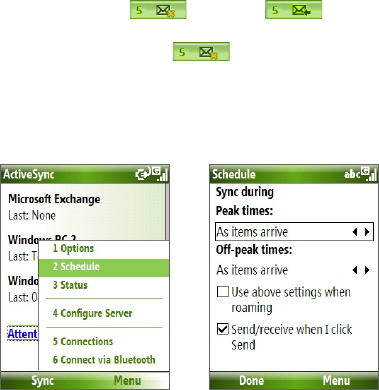
104 Working with Company E-mails and Meeting Appointments
To enable Direct Push via Comm Manager
1. Click Start > Comm Manager.
2. On the Comm Manager screen, click the Microsoft Direct Push
button. The button will turn to , which indicates that
you will receive e-mails as they arrive.
When the button is in the state, you need to manually
retrieve your e-mails.
To enable Direct Push via ActiveSync
1. In ActiveSync on your phone, click Menu > Schedule.
2. Select As items arrive in the Peak times and Off-peak times boxes.
Note When both the GPRS and Wi-Fi connections are turned on at the same time,
the Direct Push feature will always opt for GPRS, for which you could be
charged per your network operator’s service plan.
Scheduled synchronization
If you do not want to use Direct Push, you can set a regular schedule for
synchronizing Outlook e-mail and information.
1. In ActiveSync on your phone, click Menu > Schedule.
2. Select a shorter time interval in the Peak times box for you to be able
to receive e-mails more frequently.
3. Select a longer interval in the Off-peak times box.
Tip Click Menu > Peak Times to set the peak and off-peak times.
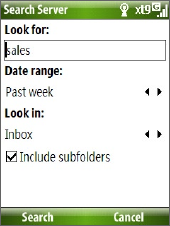
Working with Company E-mails and Meeting Appointments 105
Instant download through Fetch Mail
Fetch Mail downloads an entire e-mail immediately without the need for
you to perform a full Send/Receive action.
Requirement Fetch Mail works for your phone only if your company is
using Microsoft Exchange Server 2007 or higher.
1. Click Start > Messaging > Outlook E-mail.
2. Click an e-mail message to open it.
3. By default, only the first few kilobytes of the message is shown. To
download the whole e-mail, scroll to the bottom of the message then
click Get the rest of this message.
4. A “Downloading message” status appears. Wait for the remainder of
the message body to be downloaded.
Tip For information about changing e-mail sync options such as the initial
download size limit for e-mail, see "Customize e-mail settings" in chapter 6.
Search for e-mails on the Exchange Server
You can access messages that are not available on your phone by searching
your Microsoft Exchange Server mailbox. The search results will be
downloaded and displayed in a Search Results folder.
Requirement Your company must be using Microsoft Exchange Server
2007 or higher.
1. Click Start > Messaging > Outlook
E-mail.
2. Click Menu > Tools > Search Server.
3. In the Look for text box, enter the
search keyword.
4. Choose the Date range of messages
to search from and where to search in
Look in.
5. Click Search.
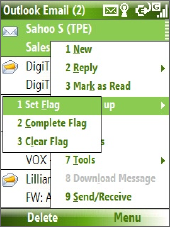
106 Working with Company E-mails and Meeting Appointments
Flag your messages
Flags serve as a reminder to yourself to follow-up on important issues or
requests that are indicated in the messages.
Requirement Flags are enabled only if e-mails are synchronized with
Microsoft Exchange Server 2007 or higher. Flags are
disabled or hidden if e-mails are synchronized with earlier
versions of Microsoft Exchange Server.
To flag or unflag a message
1. Click Start > Messaging > Outlook E-mail.
2. Select a message, or open a message.
3. Click Menu > Follow Up and select one of the following options:
• Set Flag Mark the message with
a red flag to indicate that it needs
follow up.
• Complete Flag Mark the message
with a check mark to indicate that
the issue or request in the e-mail is
already completed.
• Clear Flag Remove the flag to
unmark the message.
Note E-mail message reminders are displayed on your phone if the messages are
flagged with reminders and synchronized from the Exchange Server
Working with Company E-mails and Meeting Appointments 107
Out-of-office auto-reply
Outlook Mobile allows you to retrieve and change your out-of-office status.
Just like desktop Outlook E-mail, Outlook Mobile automatically sends an
auto-reply message when you’re not available.
Requirement Your company must be using Microsoft Exchange Server
2007 or higher.
To send out-of-office auto-reply messages
1. Click Start > Messaging > Outlook E-mail.
2. Click Menu > Tools > Out of Office.
3. From the I am currently list, select Out of the Office.
4. Enter your auto-reply message then click Done.
View SharePoint documents
When you receive an HTML e-mail containing a link to a SharePoint
document, you can click the link to access and view the document on your
phone.
Requirement Your company must be using Microsoft Exchange Server
2007 or higher.
7.3 Managing Meeting Requests
When you schedule and send meeting requests from your phone, you
can invite attendees to your meeting and check their status to know their
availability.
When you receive a meeting request, you can reply by accepting or
declining the request. The meeting request also clearly indicates whether or
not there are conflicting or adjacent meetings.
Requirement Your company must be using Microsoft Exchange Server
2007 or higher.
To check the status of invited attendees
1. Click Start > Calendar.
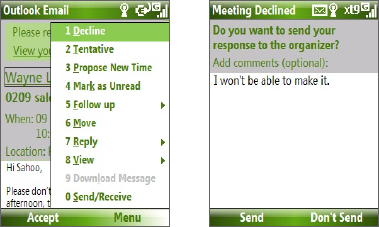
108 Working with Company E-mails and Meeting Appointments
2. Follow the procedure in “To send a meeting request” in chapter 5 to
invite required and optional attendees and send a meeting request.
3. Wait for the attendees to respond. When their responses are sent back
to you, your calendar is updated as well.
4. To check the status of the attendees who responded, click Start >
Calendar and then click the scheduled meeting.
5. In the meeting details, click Attendees.
To reply to a meeting request
1. When there’s an incoming e-mail with a meeting request, a
notification message will be displayed on your phone’s Home screen.
Scroll to Outlook e-mail and click it.
2. In the Outlook message list, click the e-mail to open it.
3. Click Accept to reply and accept the meeting request, or click Menu >
Decline if you cannot attend the meeting.
Tips • Before responding, you can check your availability during the time
of the requested meeting by clicking View your calendar.
• If the time of the meeting conflicts with your other appointments,
a “Scheduling Conflict” status appears on top of the e-mail.
3. Choose whether or not to edit the response e-mail before sending
and then click OK:
4. If you accepted the meeting request, it will automatically be added as
an appointment in Calendar on your phone.
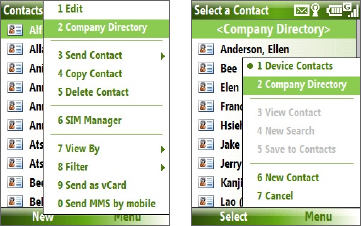
Working with Company E-mails and Meeting Appointments 109
7.4 Finding Contacts in the Company Directory
In addition to having contacts on your phone, you can access contact
information from your organization’s Company Directory.
Requirement Access to the Company Directory is available only if your
organization is running Microsoft Exchange Server
2003 SP2 or higher, and you have completed your first
synchronization with the Exchange Server.
1. Synchronize with Exchange Server if you have never done so.
2. Do any of the following:
• In Contacts, click Menu > Company Directory.
• In a new e-mail, click the To box and then click Company
Directory at the top of the list or click Menu > Company
Directory.
In Contacts In a new e-mail
• In a new meeting request using Calendar, scroll to Attendees and
click No attendees > Add Required Attendee or Add Optional
Attendee and then click Company Directory at the top of the list.
3. Enter the part or full contact name and click Search. In the search
results list, click a contact to select it.
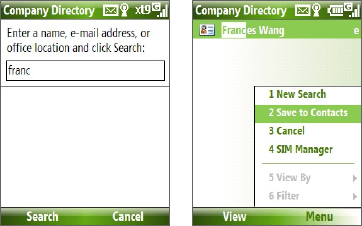
110 Working with Company E-mails and Meeting Appointments
Notes • You can save the contact from the Company Directory to your phone by
selecting the contact then clicking Menu > Save to Contacts.
• You can search on the following information as long as that information is
included in your organization’s Company Directory: First name, Last name,
E-mail name, Display name, E-mail address, or Office location.
7.5 E-mail Security
Windows Mobile on your phone protects your Outlook e-mails through
Secure/Multipurpose Internet Mail Extension (S/MIME), which allows you to
digitally sign and encrypt your messages.
Requirement S/MIME encryption and digital signatures for Windows
Mobile-based phones are available only with Exchange
Server 2003 SP2 or a later version that supports S/MIME.
If you are not using one of these products, or have not yet
synchronized, these options are unavailable.
Note You can encrypt a message with or without a certificate. However, to read an
encrypted message, you need a valid certificate to decrypt it.
To individually sign and encrypt a new message
1. Click Start > Messaging > Outlook E-mail.
2. Click Menu > New to create a new message.
3. Click Menu > Message Options.
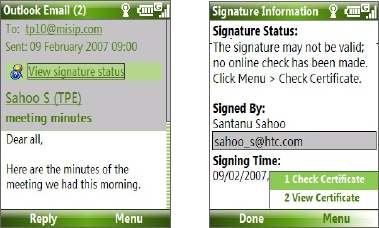
Working with Company E-mails and Meeting Appointments 111
4. From the Security list, select whether to encrypt only, sign the
message only, or do both.
5. Click Done.
To verify the digital signature on a signed message you receive
1. Open the Outlook e-mail message that has been digitally signed.
2. At the top of the message, click View signature status.
3. Click Menu > Check Certificate.
To view the details of the certificate in the message, click Menu > View
Certificate.
Note There can be several reasons why a digital signature is not valid. For example,
the sender’s certificate may have expired, it may have been revoked by the
certificate authority, or the server that verifies the certificate is unavailable.
Contact the sender to report the problem.
To digitally sign and encrypt all messages
You can set up ActiveSync to digitally sign and encrypt all outgoing
messages. You must obtain a valid certificate to sign and encrypt e-mail
messages successfully.
1. Click Start > ActiveSync.
2. Click Menu > Options.
3. Select the E-mail information type, and click Settings. On the E-mail
Sync Options screen, click Menu > Advanced.
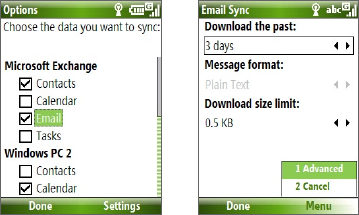
112 Working with Company E-mails and Meeting Appointments
4. Select Encrypt messages to protect your e-mails from being viewed
except by the intended recipients. Select Sign messages so that
recipients are certain that e-mails are sent by you and have not been
altered.
5. Click Menu > Choose Certificate to select a certificate for signing or
encrypting outgoing e-mail messages.
Set permissions on an e-mail message
Another way of protecting your e-mail messages is to send messages with
restricted permissions using Information Rights Management (IRM).
Requirement This works only with a Microsoft Outlook e-mail account
and if your company is using RMS Server SP1.
1. Click Start > Messaging > Outlook E-mail.
2. Create a message, then click Menu > Message Options.
3. In Permissions, do one of the following:
• To allow anyone to read the message, select Unrestricted Access.
• To prevent the message from being forwarded, printed, or copied,
select Do Not Forward.
4. Click Done.
Tip An IRM-protected message received on your phone can only be replied to or
forwarded if the message permits it.

Chapter 8
Getting Connected
8.1 Comm Manager
8.2 Ways of Connecting to the Internet
8.3 Wi-Fi
8.4 GPRS
8.5 Dial-up
8.6 Internet Explorer Mobile
8.7 Internet Sharing
8.8 Bluetooth
8.9 Windows Live Mobile
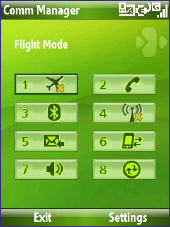
114 Getting Connected
8.1 Comm Manager
Comm Manager acts like a central switch that lets you enable or disable
phone features as well as manage your data connections easily.
To open Comm Manager:
• Click Start > Comm Manager.
1.Click to toggle between turning on or off Flight mode. Turning on Flight
mode turns off the phone, Bluetooth and WLAN functions.
2.Click to enabling or disable the phone. Click Settings > Phone to access
phone settings.
3.Click to toggle between turning on or off Bluetooth. See “Bluetooth” for
details. Click Settings > Bluetooth Settings to configure Bluetooth on your
phone.
4.Click to toggle between turning on or off Wi-Fi. Click Settings > WLAN
Settings to configure Wi-Fi on your phone. See “Wi-Fi” for details.
5. Click to toggle between automatically receiving (as items arrive) or manually
retrieving Outlook e-mails. See chapter 7 for details.
6.Click to stop active data services (e.g. GPRS). You cannot reconnect data
services in Comm Manager.
7. Click to turn on the phone's ringer or set it to vibration/mute mode.
8. Click to open ActiveSync so you can synchronize the phone and computer.
For more information regarding ActiveSync, see chapter 3.
Getting Connected 115
8.2 Ways of Connecting to the Internet
Your phone’s networking capabilities allow you to access the Internet
or your corporate network at work through wireless and conventional
connections.
You can connect to the Internet by using one of the following:
• Wi-Fi
• GPRS
• Dial-up
Note You can also add and set up the following connections:
• VPN: A VPN connection is used to access your corporate network by using
an existing Internet connection.
• Proxy: A Proxy connection is used to access the Internet using an existing
connection to your corporate or WAP network.
8.3 Wi-Fi
Wi-Fi provides wireless Internet access over distances of up to 100 meters.
Note The availability and range of your phone’s Wi-Fi signal depends on the
number, infrastructure, and other objects through which the signal passes.
To connect to an existing Wi-Fi network
1. On the Home screen, click Start > Comm Manager and click the
WLAN icon. The WLAN icon is then highlighted to indicate that WLAN
is turned on.
2. After a few seconds, a message asks you if you want to see the list of
available networks, click Yes.
3. In Select network, choose the WLAN network to connect to.
4. In Network type, select Internet and click Connect.
If you are connecting to a security-enabled network, you will be asked
to enter the WEP Key. Enter the WEP Key and click Done.
116 Getting Connected
You can check the Wi-Fi icon the Title bar on the screen to see if you are
connected to the Wi-Fi network. To see the status icons, please see “Status
Indicators” in chapter 1.
Notes
• Wi-Fi connects to the default network that is available on your phone.
However, GPRS starts by default if your phone does not detect any Wi-Fi
signal.
• In Comm Manager, click Settings > WLAN Settings > Connection Status
to check the current connection status and signal quality of each Wi-Fi
channel.
• Configure your phone so that the Wi-Fi function turns off automatically
when no signal is detected to conserve battery power. In Comm Manager,
click Settings > WLAN Settings > Wi-Fi > Menu > Wi-Fi Settings.
To create a new Wi-Fi connection
If the Wi-Fi connection you want to connect to is not in the list, you can
create a new Wi-Fi connection.
1. On the Home screen, click Start > Settings > Connections >
WLAN Settings > Wi-Fi > New.
2. Enter the Network name and Network type and click Next.
Note If you want only to connect directly to another device or computer, and not
to a network through an access point, select This is a device to device (ad-
hoc) connection.
3. Select the Authentication type and Data encryption, then click
Next. For TKIP, AES, or WEP data encryption, enter the needed
information in the remaining fields.
4. Select Use IEEE 802.1x network access control to use Extensible
Authentication Protocol (EAP). Select the EAP type depending on the
type of authentication. Click Finish.
Getting Connected 117
To increase security on the Wi-Fi network
The LEAP (Lightweight Extensible Authentication Protocol) feature of
Comm Manager helps increase security on your phone, and ensures that
nobody is able to access your network without your permission.
1. On the WLAN Settings screen, select LEAP.
2. Click Menu > New.
Note By default, the LEAP screen displays data that you entered previously.
However, you can modify or delete the data as required by clicking Menu >
Modify or Menu > Delete on the LEAP screen.
3. Enter the SSID (Service Set Identifier).
You can obtain this information from your wireless service provider.
4. Enter the user name, password, and domain.
5. Select an Authentication Type.
By default, the Authentication Type for your phone is Open System
authentication.
Note For LEAP to work correctly, the receiving phone (your phone) must be set
with the same SSID, user name, and password as the access point.
8.4 GPRS
You can use GPRS to connect to the Internet or to send and receive MMS on
your phone. When you use GPRS, you will be billed per KB (Kilobyte) when
sending or receiving information.
Note Check with your service provider how much it charges for its GPRS service.
If GPRS settings are not preset on your phone, obtain the Access point
name from your wireless service provider. Also, check with your wireless
service provider if a user name and password are required.
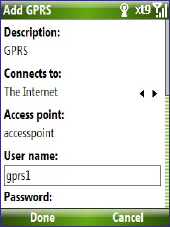
118 Getting Connected
To set up a new GPRS connection
1. On the Home screen, click Start >
Settings > Connections > GPRS >
New.
2. In Description, enter a name for the
connection.
3. In Connects to, select The Internet.
4. Enter the name of the GPRS Access
point of your wireless service provider.
5. Enter the appropriate information in
the remaining fields, if required by
your wireless service provider.
6. Click Done.
8.5 Dial-up
When you use your phone to dial up to your ISP and connect to the Internet
or to your corporate network, you will be billed by the number of minutes
that you use.
To set up a dial-up connection for browsing the Internet
1. On the Home screen, click Start > Settings > Connections >
Dial-up > Add.
2. In Description, enter a name for the connection.
3. In Connects to, select The Internet.
4. Enter the appropriate information in the remaining fields.
5. Click Done.
Getting Connected 119
To set up a dial-up connection to your corporate network
1. On the Home screen, click Start > Settings > Connections >
Dial-up > Add.
2. In Description, enter a name for the connection.
3. In Connects to, select Work.
4. Enter the appropriate information in the remaining fields.
5. Click Done.
Advanced options
From the Connections screen, you can access advanced options to specify
the service provider, the number of redial attempts, the amount of idle time
to wait before disconnecting, and so on.
1. On the Home screen, click Start > Settings > Connections > Menu >
Advanced.
2. Select a network service provider for each connection type. You can
choose Automatic to allow the phone to set a service provider for
each connection by default.
3. Click Menu > Options.
4. Choose the appropriate information in the remaining fields.
5. Click Done.
Add a URL exception
Some URLs for Web pages on your company intranet may use periods, for
example: intranet.companyname.com. To view these pages in Internet
Explorer Mobile, you must create a URL exception.
1. On the Home screen, click Start > Settings > Connections > Menu >
Advanced.
2. Click Menu > Work URL Exceptions > Menu > Add.
3. In URL Pattern, enter the URL name. To add multiple URLs, use a
semicolon (;).
4. Click Done.
Note You do not need to create URL exceptions for Internet URLs.
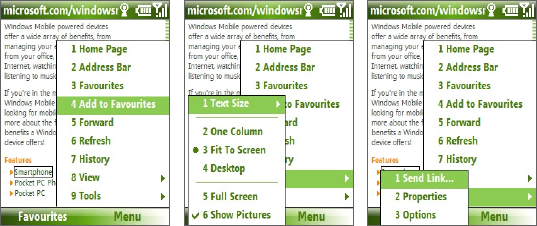
120 Getting Connected
8.6 Internet Explorer Mobile
Internet Explorer Mobile is a full-featured Internet browser, optimized for
use on your phone.
To open Internet Explorer
• On the Home screen, click Start > Internet Explorer.
Browsing the Web
1. In Internet Explorer, click Menu > Address Bar.
2. Enter the address and click Go.
3. Use the NAVIGATION CONTROL to browse the Web page. Press
CENTER OK when a link is highlighted to access it.
While browsing the Web, click Menu to open a list of options that will
let you change the view, save Favorites, and set Internet Explorer Mobile
preferences, and more.
Click Menu > View and then
select the text size and type
of view you want to use
while browsing a Web page.
Click Menu > Tools to let you
send the link via e-mail, view
the page’s properties, or set
Internet Explorer Mobile
preferences.
Click Menu > Add to
Favorites to save the current
Web page in your Favorites
folder. Click Favorites to
access your Favorites folder.
For more information about Internet Explorer Mobile, please go to
http://www.microsoft.com/windowsmobile/help/smartphone/
browseinternet.mspx
Getting Connected 121
8.7 Internet Sharing
With Internet Sharing, you can use your phone as an external modem for
another device such as a PDA or notebook computer.
Notes • Make sure your phone has a SIM card installed, and you have set up a
GPRS or phone dial-up modem connection on your phone. If your phone
has not been set up with a data connection yet, click Menu > Connection
Settings on the Internet Sharing screen. For more information about
setting up a GPRS connection, see "GPRS". For more information about
setting up a phone dial-up connection, see "Dial-up".
•
Before using Internet Sharing, disable ActiveSync on your computer.
To disable ActiveSync, open ActiveSync then click File > Connection
Settings and clear Allow USB Connections.
Set up the phone as a modem
To set up the phone as a USB modem
1. On your phone, click Start > Internet Sharing.
2. In the PC Connection list, select USB.
3. In the Network Connection list, select the name of connection that
your phone uses to connect to the Internet.
4. Plug in the USB cable between your phone and the computer.
5. Click Connect.
To end the Internet connection
• On the Internet Sharing screen, click Disconnect.
To set up the phone as a Bluetooth modem
You can connect your phone to a computer through Bluetooth and use the
phone as a modem for the computer.
To learn how to set up the phone as a Bluetooth modem, see “Use the
phone as a Bluetooth modem” in this chapter.
122 Getting Connected
8.8 Bluetooth
Bluetooth is a short-range wireless communications technology. Phones
with Bluetooth capabilities can exchange information within a distance of
about 10 meters without requiring a physical connection.
Bluetooth modes
Bluetooth on your phone operates in three different modes:
1. On. Bluetooth is turned on. Your phone can detect other Bluetooth-
enabled devices, but not vice versa.
2. Off. Bluetooth is turned off. In this mode, you can neither send nor
receive information using Bluetooth.
3. Visible. Bluetooth is turned on, and all other Bluetooth-enabled
devices within range can detect your phone.
Note By default, Bluetooth is turned off. If you turn it on, and then turn off your
phone, Bluetooth also turns off. When you turn on your phone again,
Bluetooth automatically turns on.
To turn on or off Bluetooth on your phone
You can enable Bluetooth by clicking the Bluetooth button in the Comm
Manager. You can also do the following:
1. On the Home screen, click Start > Settings > Connections >
Bluetooth.
2. Click Bluetooth > Menu > Turn On Bluetooth.
To turn off Bluetooth capabilities on your phone, click Bluetooth > Menu >
Turn Off Bluetooth.
To make your phone visible
1. On the Home screen, click Start > Settings > Connections >
Bluetooth.
2. Click Bluetooth > Menu > Turn On Visibility.
Tip Enter a Bluetooth phone name for your phone. This will be the phone
name that will be shown on another Bluetooth-enabled device when
it searches and detects your phone. To enter a name, on the Bluetooth
screen, click Security and enter a Device name.
Getting Connected 123
Bluetooth partnerships
A Bluetooth partnership is a relationship that you create between your
phone and another Bluetooth-enabled device in order to exchange
information in a secure manner.
To create a Bluetooth partnership
1. On the Home screen, click Start > Settings > Connections >
Bluetooth.
2. Click Bluetooth > Add new device.
Your phone searches for other Bluetooth-enabled devices and lists
them.
3. Select the desired device name in the list and click Next.
4. Enter a passcode (1 up to 16 characters) to establish a secure
connection, then click Next.
5. Wait for the paired device to accept the partnership:
6. On your phone, a message will appear, indicating that your phone has
connected with the paired device. Click OK.
7. The name of the paired device is then displayed. You may edit and
enter a new name for that device, then click Next.
8. Select the check boxes of services that you want to use from the
paired device and click Done.
To accept a Bluetooth partnership
1. Ensure that Bluetooth is turned on and in visible mode.
2. Click Yes when prompted to establish a partnership with the other
device.
3. Enter a passcode (the same passcode that is entered on the device
requesting the partnership) to establish a secure connection.
4. Click Next.
5. A message will appear, indicating that your phone has connected
with the paired device. Click OK.
6. The name of the paired device is then displayed. You may edit and
enter a new name for that device, then click Next.
124 Getting Connected
7. Select the check boxes of services that you want to use from the
paired device.
8. Click Done. You can now exchange information with the other device.
To change the display name of a Bluetooth device
1. On the Home screen, click Start > Settings > Connections >
Bluetooth.
2. Click Bluetooth and then on the screen, select a Bluetooth device.
3. Click Menu > Edit.
4. Enter a new display name for the Bluetooth device, then click Next.
5. Click Done.
To delete a Bluetooth partnership
1. On the Home screen, click Start > Settings > Connections >
Bluetooth.
2. Click Bluetooth and then on the screen, select a Bluetooth device.
3. Click Menu > Delete, and then click Yes in the confirmation screen.
4. Click Done.
Connect a Bluetooth hands-free or stereo headset
For hands-free phone conversations or to listen to music, you can use a
Bluetooth hands-free or stereo headset.
Note You need a Bluetooth stereo headset to listen to music.
To connect a Bluetooth hands-free or stereo headset
1. Make sure that both your phone and the Bluetooth headset are
turned on and within close range, and that the headset is visible.
Refer to the manufacturer’s documentation to find out how to set the
headset in visible mode.
2. On the Home screen, click Start > Settings > Connections >
Bluetooth.
3. Click Bluetooth > Add new device. Your phone searches for other
Bluetooth-enabled devices and displays them in the list.
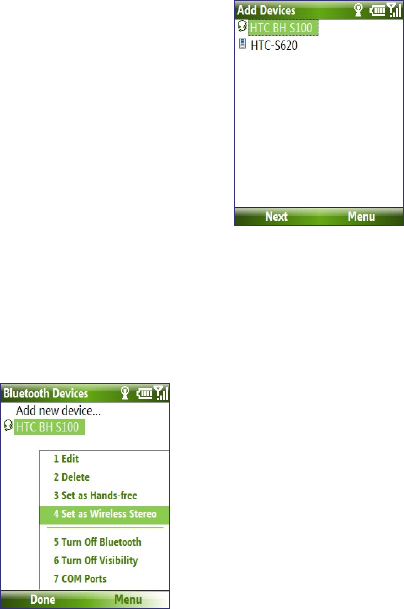
Getting Connected 125
4. Select the name of the
headset, and click Next.
5. In Passcode, enter the
alphanumeric passcode for
the Bluetooth headset, then
click Next. The passcode is
usually “0000”.
A message will appear
saying that your phone has
connected to the headset,
click OK.
6. Enter the display name for
the headset and click Next.
7. Select the check boxes for the Wireless Stereo (if available) and
Hands Free services, and click Done.
Note If the Bluetooth stereo headset becomes disconnected, turn the headset on
and repeat steps 1 to 2 above. Select the stereo headset and click Menu >
Set as Wireless Stereo.
126 Getting Connected
Beam information using Bluetooth
You can beam information, such as contacts, calendar items, and tasks, as
well as files from your phone to your computer or to another Bluetooth-
enabled device.
Notes
• If your computer does not have built-in Bluetooth capabilities, you need to
connect and use a Bluetooth adapter or dongle on your computer.
• Before beaming items to your computer, open Bluetooth Configuration or
Bluetooth Settings in the Control Panel and check if there’s an option for
setting a location for saving beamed items.
To beam information from your phone to a computer
1. Set Bluetooth on your phone to visible mode. For information about
this, see “To make your phone visible”.
2. Next, set Bluetooth on your computer to visible mode, create a
Bluetooth partnership, then enable your computer to receive
Bluetooth beams.
If your computer has Windows Vista or Windows XP SP2 and your
computer’s Bluetooth adapter is supported by your Windows version,
do the following steps:
a. On your computer, open Bluetooth Devices from the Control
Panel then click the Options tab.
b. For Windows Vista, select Allow Bluetooth devices to find this
computer.
For Windows XP, select Turn discovery on and Allow Bluetooth
devices to connect to this computer.
c. Create a Bluetooth partnership between your phone and
computer. For information about creating a partnership, see
“Bluetooth partnerships”.
d. In the Options tab of Bluetooth Devices, select Show the
Bluetooth icon in the notification area.
e. To enable your computer to receive Bluetooth beams, right-click
the Bluetooth icon at the bottom-right of your computer screen
and select Receive a File.
Getting Connected 127
3. Now you are ready to beam. On your phone, select an item to beam.
The item can be an appointment in your calendar, a task, a contact
card, or a file.
4. Click Menu > Beam [type of item].
5. Select the device name to which you want to beam to.
6. Click Beam.
7. If you beamed a calendar, task, or contact item to your computer
and it is not automatically added to Outlook, click File > Import and
Export to import it to Microsoft Outlook on your computer.
To beam information to a Bluetooth-enabled device such as another phone,
create a Bluetooth partnership then do steps 3 to 6 in the above procedure.
Tip The default folder on your computer where beamed items are stored may be
Windows XP: C:\Documents and Settings\your_username\My Documents
Windows Vista: C:\users\your_username\My Documents
Bluetooth Explorer and Bluetooth file sharing
Bluetooth Explorer searches for other Bluetooth devices that have file
sharing enabled and lets you access their Bluetooth shared folder. You can
copy files from and to their shared folder, and create subfolders in it. When
you enable Bluetooth file sharing on your device, other Bluetooth-enabled
devices will also be able to access your Bluetooth shared folder.
To enable Bluetooth Explorer and Bluetooth file sharing
on your phone
1. Click Start > Settings > Connections > Bluetooth > FTP.
2. Select the Enable Bluetooth Explorer check box. This makes the
/Bluetooth phone folder visible in File Explorer.
3. Select the Enable File Sharing check box. Click Browse to change
the folder to share.
To use Bluetooth Explorer
1. Bluetooth Explorer is integrated with the File Explorer program. You
can open it by clicking Start > Programs > Bluetooth Explorer or
by clicking the Bluetooth folder under the My Device folder in File
Explorer.
128 Getting Connected
2. Bluetooth Explorer then scans for other Bluetooth-enabled devices.
From the list, select a Bluetooth device you want to connect to. You
may need to enter a passcode in order for you to connect to the
device.
3. If there are files contained in the Bluetooth shared folder on the other
device, you will be able to see them on the Bluetooth Explorer screen.
Select a file and click Menu > Edit and choose to cut or copy the files.
4. Click Up twice.
5. Navigate to the folder where you want to paste the files on your
device, then click Menu > Edit > Paste.
Use the phone as a Bluetooth modem
You can connect your phone to a notebook or desktop computer through
Bluetooth and use the phone as a modem for the computer.
For the computer to use the Internet connection of your phone, activate
Internet Sharing on your phone, then set up a Bluetooth Personal Area
Network (PAN) between the computer and your phone.
1. On your phone, turn on Bluetooth and set it to Visible mode.
2. Initiate a Bluetooth partnership from your phone by following the
steps in “To create a Bluetooth partnership.“
3. Click Start > Internet Sharing.
4. Select Bluetooth PAN as the PC Connection.
5. From the Network Connection list, select the name of the
connection that your phone uses to connect to the Internet.
6. Click Connect.
7. On your computer, set up a Bluetooth Personal Area Network (PAN)
with your phone:
• For Windows XP
a. Click Start > Control Panel > Network Connections.
b. Under Personal Area Network, click the Bluetooth Network
Connection icon.
c. Under Network Tasks, click View Bluetooth network devices.
Getting Connected 129
d. In the Bluetooth Personal Area Network Devices dialog box, select
your phone, then click Connect.
• For Windows Vista
a. Click Start > Control Panel > Network and Sharing Center.
b. Click Manage network connections and then under Personal
Area Network, double-click Bluetooth Network Connection.
c. In the Bluetooth Personal Area Network Devices dialog box, select
your phone, then click Connect.
8. On the Internet Sharing screen on your phone, check if a connected
status is displayed, which indicates that your computer has been
successfully connected to the Internet using your phone as a
Bluetooth modem.
8.9 Windows Live Mobile
Windows Live Mobile gives you full Internet experience on your phone.
Windows Live Mobile offers the following key features:
• Windows Live Search. Windows Live’s search engine for finding
information on the web.
• Windows Live Contacts. Address book for storing Windows Live Mail,
Windows Live Messaging, and Hotmail contacts.
• Windows Live Messenger Mobile. Next generation of MSN
Messenger Mobile.
• Windows Live Mail. Next generation of Hotmail.
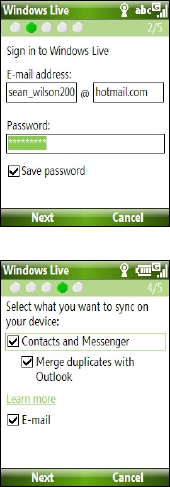
130 Getting Connected
Set up Windows Live Mobile
The first time you use Windows Live Mobile, sign in by using your Windows
Live ID, which is your Windows Live Mail or Hotmail address, and password.
To set up Windows Live Mobile for the first time
1. Click Start > Windows Live.
2. Click Sign in to Windows Live.
3. On the next screen, click the links to
read the Windows Live Term of Use and
the Microsoft Privacy Statement. After
reviewing them, click Accept.
4. Enter your Windows Live Mail or Hotmail
address and password, then click Next.
5. Choose whether or not to show
Windows Live’s search bar and
applications on the Today screen then
click Next.
6. Choose what information you want to
synchronize online with your phone.
If you choose to synchronize Contacts
and Messenger, your online contacts
will be added to the contact list and to
Windows Live Messenger Mobile on
your phone.
If you choose to synchronize E-mail,
your Windows Live Mail or Hotmail
inbox messages will be downloaded to
your phone.
7. Click Next.
8. After synchronization is complete, click
Done.
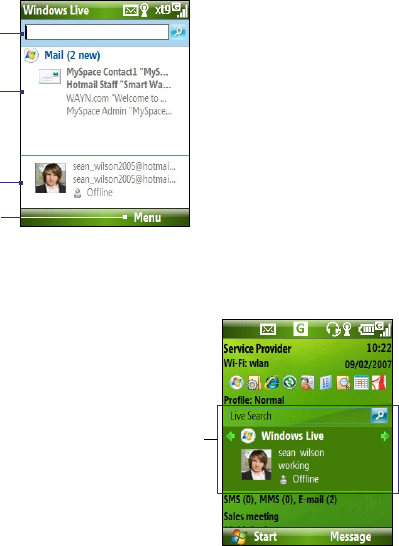
Getting Connected 131
The Windows Live Mobile interface
On the main interface of Windows Live Mobile, you will see a search bar,
navigation bar, and an area where you can customize to show your picture.
1This is the Windows Live Search bar.
2Press NAVIGATION left or right to
switch among Live Mail, Messenger,
and Sync status. Click to open/
activate the selected Windows Live
component.
3Click to access Windows Live
Messenger settings.
4Click Menu to access and change
settings.
2
1
3
4
If you chose to display the search bar and Windows Live applications on the
Today screen when you were setting up Windows Live, you’ll see them on
the Today screen:
Search bar and
Windows Live applications
To show or hide them, open Windows Live and click Menu > Options >
Home screen options.
132 Getting Connected

Chapter 9
Experiencing Multimedia
9.1 Camera
9.2 Pictures & Videos
9.3 Windows Media Player Mobile
9.4 Audio Manager
9.5 Midlet Manager
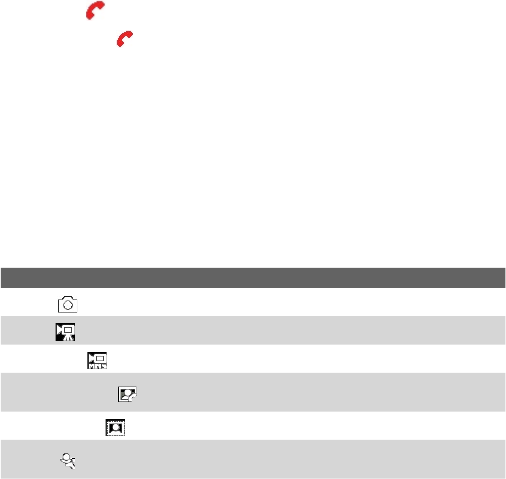
134 Experiencing Multimedia
9.1 Camera
Taking photos and shooting video clips are easy with your phone’s built-in
camera.
To open Camera
Do any of the following:
• Press the CAMERA button on the right side of the phone.
• On the Home screen, click Start > Camera.
To exit Camera
• Press ( ).
Note Pressing ( ) simply "minimizes" the Camera program, it is still runing in the
background. To close the Camera program, go to Task Manager.
Take a photo or capture a video clip
Aim the camera at the subject and then press CENTER OK to take the shot.
When capturing video, press CENTER OK to start recording; press it again to
stop.
Capture modes
The Camera program lets you capture pictures and video clips by using
various built-in modes. The title bar displays the active capture mode.
The available capture modes are as follows:
Capture mode Function
Photo ( ) Captures standard still images.
Video ( )Captures video clips, with or without audio.
MMS Video ( ) Captures video clips suitable for sending via MMS.
Contacts Picture ( ) Captures a still image suitable for assigning as an
identification photo to a contact.
Picture Theme ( ) Captures still images and places them within frames.
Sports ( )Captures a sequence of still images (3 or 5 frames)
automatically for a short duration at a defined frequency.
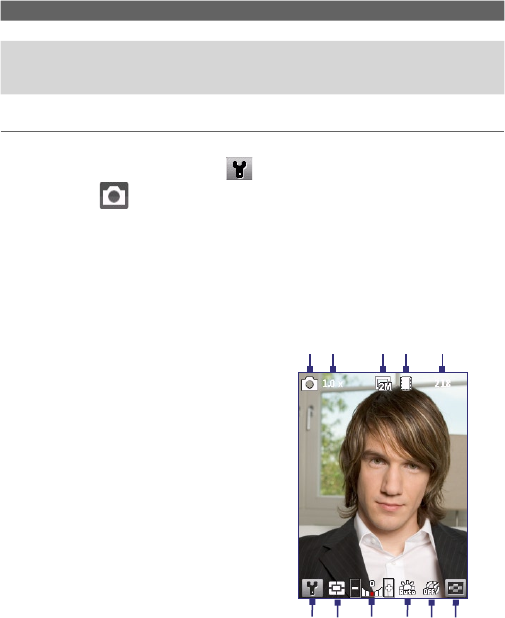
Experiencing Multimedia 135
Using the above capture modes, the camera captures files in the following
formats:
Capture type Format
Still Image JPEG
Video Motion-JPEG AVI (.avi)
MPEG-4 (.mp4)
H.263 baseline (.3gp)
MMS Video MPEG-4 (.mp4)
H.263 baseline (.3gp)
To change the capture mode
1. On the Camera screen, click and then keep clicking Next Setting
to select .
2. Press NAVIGATION right to open the Mode list.
3. Click a capture mode from the list and then click OK.
Camera mode icons and indicators
The Camera [Photo] screen
1 Indicates the current capture
mode.
2 Indicates the current zoom
ratio. Press NAVIGATION up or
down to increase or decrease
the zoom level.
3 Indicates the current image
or video size based on the
resolution you chose.
4 Indicates where the captured
images and video clips will be
saved.
1 42 3 5
678 9 10 11
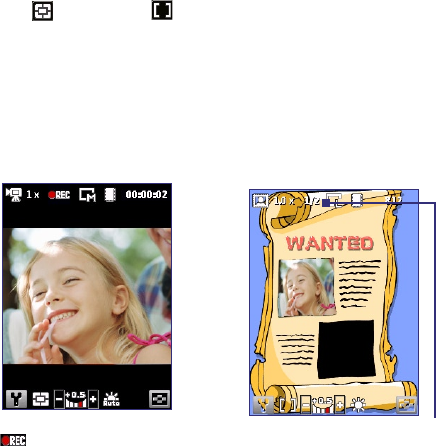
136 Experiencing Multimedia
5 Depending on the capture mode, this shows the remaining, available
shots of pictures that you can take or remaining duration that can be
recorded. While recording video, this shows the recorded duration.
6 Click to open the Camera Settings screen.
7 Indicates the current Metering mode being used, either Center Area (
) or Average ( ).
8 Adjust the exposure value from -2 EV to +2 EV (increments of 0.5) by
pressing NAVIGATION left or right.
9 Indicates the current white balance setting.
10 Indicates the current self-timer setting while capturing images.
11 Click to view the picture or video in Pictures & Videos.
The Camera [Video] screen The Camera [Picture Theme] screen
The Recording Status indicator
blinks while video recording
is in progress.
Displays the current and total
number of photos that can be
taken using the selected template.
Use zooming
Before capturing a still image or a video clip, you can first zoom in to make
the object in focus move closer, and you can zoom out to make the object
move farther away. In all capture modes, press NAVIGATION up on your
phone to zoom in, NAVIGATION down to zoom out.
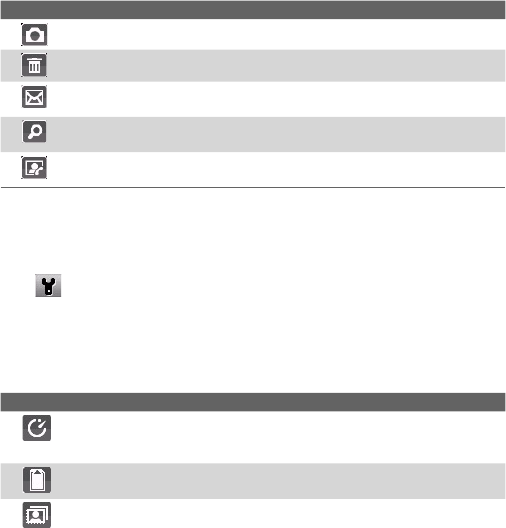
Experiencing Multimedia 137
The camera zoom range for a picture or video depends on the capture
mode and capture size. Also, please note the capture sizes available for
certain capture formats also vary from one capture mode to another.
The Review screen
After capturing a photo or video, you will be presented with options that
you can do with the captured media file.
Icon Function
Click to go back to Camera screen.
Click to delete the captured image or video clip.
Click to send the captured image or video clip to someone via e-mail or
MMS.
Click to switch to Pictures & Videos to show the still image, or switch to
Windows Media Player to play back the video clip.
Click to associate the photo to a selected contact. (For Contacts Picture
mode only)
Note After you have taken photos in Sports mode, the total number of
consecutive shots is shown at the lower right corner of the Review screen.
Press NAVIGATION up or down to browse through the sequence of photos.
Customize Camera settings
Click on the Camera screen to open the Camera settings screen where
you can activate self-timer, change the ambience, customize capture
settings, and more. Use the NAVIGATION CONTROL and the left SOFT KEY to
go through the available settings. The following table provides a list of the
general options in the menu.
Option Allows you to
Select the Self-timer option for capturing images: Off, 2 seconds, or 10
seconds. Selecting 2 seconds or 10 seconds delays the capturing by the
specified time after you press CENTER OK.
Select whether to save the file in the phone memory or on the memory
card.
Only available in Picture Theme mode. Allows you to select a template to use
for Picture Theme mode.
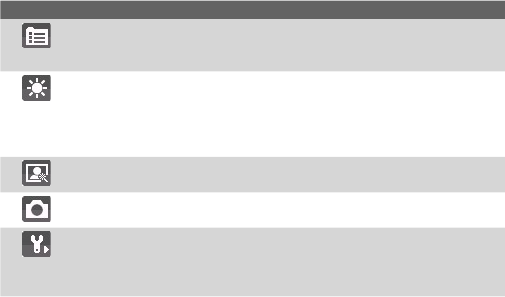
138 Experiencing Multimedia
Option Allows you to
Only available in Sports mode. The Capture Speed option determines the
interval between shots. The Snapshots option determines how many shots
to take with a single press of CENTER OK.
Specify
the white balance setting such as Auto, Daylight, Night,
Incandescent, and Fluorescent to suit the lighting environment. You can
also
choose a special effect such as Grayscale, Sepia, or Cool to apply to
your photos or video clips. When you apply a special effect, white balance is
disabled.
Choose the resolution to use and set the metering mode. When capturing
images, you can also set the Quality and enable Time Stamp.
Switch between different capture modes such as Photo, Video, Contacts
Picture, and more. For details, see “Capture modes” earlier in this chapter.
Access more settings that lets you customize the Camera or Video
Recorder functions. You can customize settings, such as the capture
format, camera shutter sound, flicker adjustment, recording limit, and
more.
9.2 Pictures & Videos
The Pictures & Videos program allows you to view and manage media files
on your phone.
To copy a picture or video clip to your phone
You can copy pictures from your PC and view them on your phone.
• Copy the pictures and video files from your PC or a storage card to the
My Pictures folder on your phone.
For more information about copying files from your PC to your phone, see
Windows Mobile Device Center or ActiveSync Help on your PC.
Note You can also copy pictures and video files from your PC to your phone using
a memory card. Insert the memory card into the memory card slot on your
phone, and then copy them from your PC to the folder you created on the
memory card.
To view media files
1. On the Home screen, click Start > Pictures & Videos.
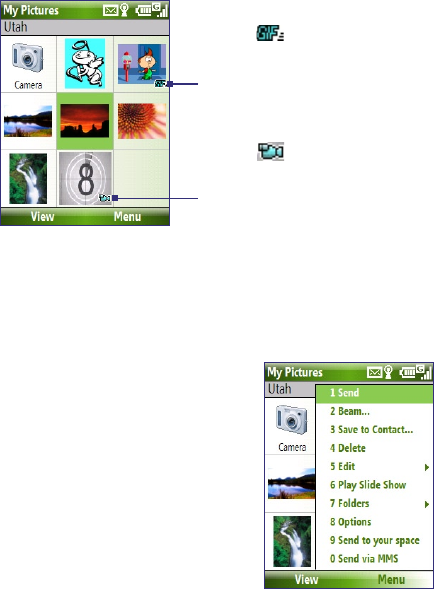
Experiencing Multimedia 139
2. Select a media file and click View or Play (if video file) to view or play
back the file.
This icon indicates that
the file is a GIF animation
file. Click View to play back
the file.
This icon indicates that the
file is a video file. Click Play to
play back the file in Windows
Media Player Mobile.
Note If you cannot find the media file in the default My Pictures folder,
click Menu > Folders > My Device to go to other folders.
Pictures & Videos menu
Select a media file onscreen and click Menu to open a list of options that
you can do with the selected media file.
You can choose to send the selected
media file via one of your messaging
accounts, beam it to another device,
play the pictures as a slide show, send
the picture to your Windows Live
MySpace account, and more.
Click Options to customize picture
settings and slide show playback
preferences.
Note The available menu options depend
on the selected media file.
When viewing a picture file, click Menu > Use as Home Screen to set the
picture as your Home Screen background. You can also do minor touch ups
to the picture such as rotate and crop by clicking Menu > Edit.
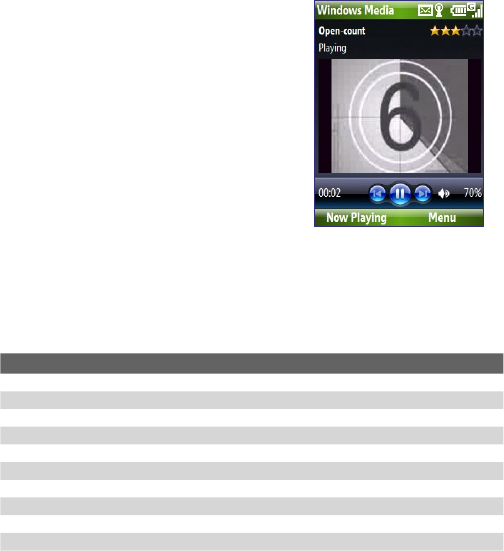
140 Experiencing Multimedia
9.3 Windows Media Player Mobile
You can use Microsoft® Windows Media®
Player Mobile for Smartphone to play
digital audio and video files that are stored
on your phone or on a network, such as on
a Web site.
To open Windows Media Player Mobile,
click Start > Windows Media.
About the controls
By default, these hardware buttons are assigned to Windows Media Player
Mobile functions.
Tip To change the assigned hardware buttons, on the Playback screen, click
Menu > Options > Buttons.
To Press
Play or pause CENTER OK
Skip to a previous file NAVIGATION left
Skip to the next file NAVIGATION right
Increase the volume NAVIGATION up
Decrease the volume NAVIGATION down
Turn the sound on or off quickly (mute) #
Switch to full screen during video playback
0
Change rating *
Fast-forward a file NAVIGATION right (hold)
Rewind a file NAVIGATION left (hold)
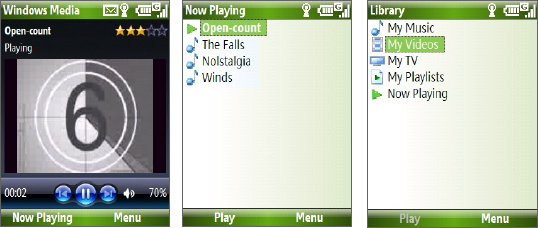
Experiencing Multimedia 141
About the screens and menus
Windows Media Player Mobile has three primary screens:
Library screen
The screen that lets you
quickly find your audio files,
video files, and playlists.
Now Playing screen
This special playlist indicates
the current file being played
and files that are queued up
to play next.
Playback screen
The default screen that
displays the playback
controls and the video
window.
Click Menu to open a list of options that you can do in a particular screen
The commands on this menu vary, depending upon which screen you are
viewing.
About licenses and protected files
Some media files have associated licenses that protect them from being
unlawfully distributed or shared.
If you want to copy a protected file from your PC to your phone, use the
Windows Media Player on your PC to synchronize the file to your phone.
This will ensure that the license is copied along with the protected file. For
more information about synchronizing files to your phone and other mobile
devices, see the Windows Media Player Help.
Note You can view the protection status for a file by checking its file properties
(Menu > Properties).
142 Experiencing Multimedia
Copy files to your phone
Use the Sync feature in Windows Media Player on your PC to synchronize
(copy) digital media files from your PC to your phone. Using Sync ensures
that protected files and album art (for skins) are copied to your phone
correctly.
To synchronize content to your phone automatically
1. On your PC, start Windows Media Player and then connect your
phone to your PC.
2. In the Device Setup Wizard, type a name for the phone and click
Finish.
3. On the leftmost pane, right-click your phone and select Set Up Sync.
Note You can also sync your storage card if you have one installed on your
phone. To sync, right-click Storage Card.
4. On the Device Setup dialog box, select the Sync this device
automatically and then select the playlist(s) that you want to sync
between the PC and your phone.
5. Click Finish.
The files begin synchronizing to your phone. The next time you
connect your phone to your PC while Windows Media Player is running,
synchronization will start automatically.
To synchronize and copy content manually to your phone
1. If you have not set up synchronization between your phone and
PC, follow steps 1 to 3 in “To synchronize content to your phone
automatically.”
2. Click the Sync tab on the Windows Media Player. Select a Playlist or a
Library on the left panel of the Windows Media Player.
3. From the content list, drag files you want to sync to your phone to the
right panel of the Windows Media Player.
4. Click Start Sync to start copying files to your phone.
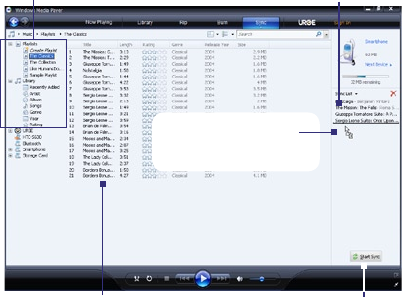
Experiencing Multimedia 143
Playlists and Library list
Start Sync
Playlist or library content list
Drag files from the content
list to sync to your phone
Dragging a file into the
Sync list
Notes
• Always use Windows Media Player 11 on your PC to synchronize (copy) files
to your phone.
• Audio files copy faster if Windows Media Player is configured to
automatically set the quality level for audio files copied to your phone. For
more information, see the Windows Media Player Help.

144 Experiencing Multimedia
Play media
To play media on your phone
Use the library to find and play songs, videos, and playlists that are stored
on your phone or storage card.
1. If you are not on the Library screen, click Menu > Library.
2. If necessary, on the Library screen, click Menu > Library, and then
select the library that you want to use.
3. In most cases, Windows Media Player Mobile automatically updates
the library. However, you can manually update the library to ensure
that it contains new files that you recently copied to your phone or
storage card. Click Menu > Update Library to manually update the
library list.
4. Select a category (for example, My Music or My Playlists), select the
item that you want to play (such as a song, album, or artist name), and
then click Play.
Note To play a file that is stored on your phone but is not in a library, on the Library
screen, click Menu > Open File. Select the item that you want to play (such
as a file or a folder), and click Play.
Troubleshooting
For more information, see the Troubleshooting Windows Media Player
Mobile page at the Microsoft Web site (http://www.microsoft.com/
windows/windowsmedia/player/windowsmobile/troubleshooting.aspx).
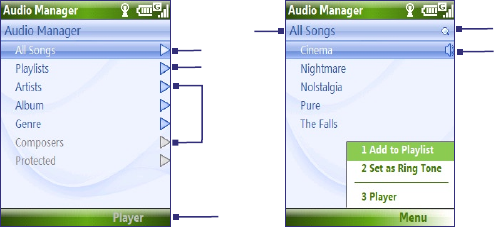
Experiencing Multimedia 145
9.4 Audio Manager
Audio Manager is a music browser and player in one. It gives you access to
all the music files on your phone, and allows you to easily browse for the
music that you want to play by organizing music into categories.
To open Audio Manager
• Click Start > Audio Manager.
Notes • Audio Manager searches for all music files stored on your phone memory
and storage card that have the following audio formats: MP3, WMA, AAC,
and AAC+. It will search in the following locations:
Phone: \Music (including all subfolders; when there are music files
synchronized between the phone and PC)
\My Documents (including all subfolders)
Storage card: \Storage Card (including all subfolders)
• Music files are categorized under Artists, Album, Genre, etc. if such
metadata are found in the files.
Library
On the Audio Manager’s Library screen, an arrow that appears in an item
indicates that there is a submenu available. Use the NAVIGATION CONTROL
to go through the items and press CENTER OK to open the submenu.
5
7
6
Library: All Songs screen
1
3
4
2
Library: Main screen

146 Experiencing Multimedia
No. Description
1Open the All Songs submenu where you can browse music files by file name or
song title.
2Open the Playlists submenu where you can create playlists and play them back.
3Open a submenu where you can browse music files by the selected category.
4Switch to the Music Player screen. (Music Player does not automatically start
playback. Press CENTER OK to start playback.)
5Shows the current submenu name.
6Shows a Search icon when the music database in Audio Manager is being
updated. This occurs when music files have been added, renamed, or removed
on the phone memory or storage card.
7Shows the song titles or file names of music files when you are in the All Songs
submenu. Use the NAVIGATION CONTROL to select a music file and play it in the
Music Player.
Shows more submenus when you are in one of the category screens, such as
Artists, Album, etc. Press CENTER OK to open a submenu.
Tip Press NAVIGATION left or to go back to the upper-level menu.
When you press CENTER OK on a category on the Library’s Main screen,
you will see more submenus which may have deeper levels of menus. For
example, when you select Artists, another level of submenus will be listed
showing artist names. Just keep opening the submenus until you reach the
level where song titles can be selected for playback.
Music files that are protected by Digital Rights Management (DRM) will be
listed under the Protected category. A lock icon shown before song titles
indicates that the music files are protected. A cross-marked lock icon shown
before song titles indicates that the rights for the music files have expired,
and you will not be able to play them.
Note When you exit Audio Manager and open it again, it will display the last
submenu that you were in. Press NAVIGATION left until you reach the
Library's Main screen.
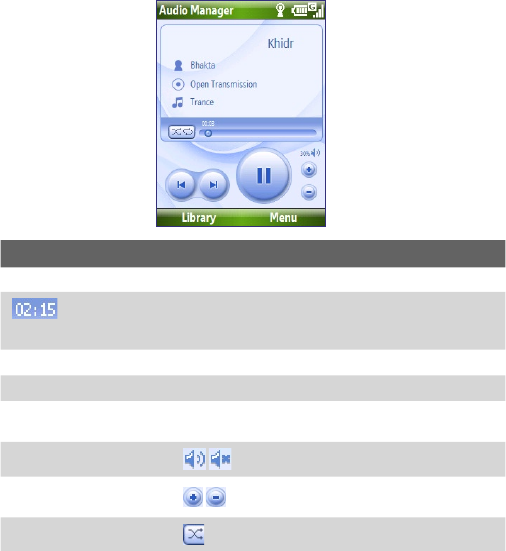
Experiencing Multimedia 147
Music Player
Music Player is integrated with Audio Manager, and lets you play back
music files. After selecting a song in the Library, Music Player opens and
automatically plays it.
Note If the last screen you were in was the Music Player when you closed Audio
Manager, next time you launch Audio Manager, it will open Music Player
directly. To switch back to the Library, click Library.
Control Does this
Press CENTER OK Play/Pause the song.
Shows the playback time. Click Menu > Time Display
to choose the display format for the playback time
(Elapsed time or Remaining time).
Press and hold 1Move backward in a song.
Press and hold 3Move forward in a song.
Press NAVIGATION
left/right Go to the previous/next song.
Press 8 Mute/Unmute.
Press NAVIGATION
up/down Increase/Decrease the volume.
Press 4 Shuffle songs during playback.
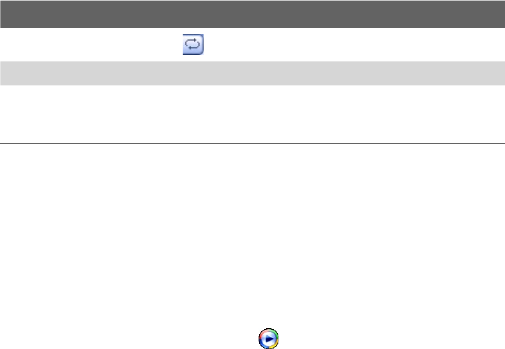
148 Experiencing Multimedia
Control Does this
Press 7 Loop songs during playback.
Library Return to the Library screen.
Menu Open a menu where you can choose to add the
current song to a playlist, set the playback mode, set
the song as ring tone, and more.
Playlists
A playlist is a list of music files that play in a sequential order. The Playlists
screen shows the current playlists that are found on the phone memory and
storage card.
There are two types of playlists that will be shown on the Playlist screen:
• Windows Media Player playlists. These are playlists that are in
Windows Media Player Mobile’s Library (which is synchronized with
Windows Media Player on your computer), and they are indicated by
the Windows Media Player icon ( ). They can be played in Audio
Manager’s Music Player but cannot be edited.
• Custom playlists. These are playlists that are created in Audio
Manager and can be edited.
Notes • Audio Manager searches for playlists in the following locations:
Phone: \Playlists\Application Data\HTC\AudioManager\playlists
Storage card: \Storage Card\Playlist
• If a Windows Media Player playlist contains a combination of music, video
and image files, Audio Manager accesses the music files only and filters
out the other media types.
Experiencing Multimedia 149
To create a playlist
1. On the Library’s Main screen, select Playlists and press CENTER OK.
2. On the Playlists screen, click Menu > New.
3. Enter a Playlist name then click OK.
4. On the Playlists screen, select the playlist you have just created and
then click Edit.
5. Click Menu > Add.
6. Select the songs you want to add to the playlist by pressing CENTER
OK, or click Menu > Select All to choose all the songs.
7. Click OK thrice to return to the Playlists screen.
Set music as ring tone
Audio Manager allows you to select your favorite music and set it as a ring
tone for your phone.
1. Use the NAVIGATION CONTROL to select a song in the Library, or
select a song to play it in Music Player.
2. Click Menu > Set as Ring Tone.
Note If the selected song is in MP3 format, you can trim it first to make it shorter.
Click Trim to open the MP3 Trimmer and trim the song. For more information
about trimming, see “MP3 Trimmer”.
4. Select Set as Default Ring Tone and press CENTER OK.
5. A confirmation message is then displayed. Click OK.
Tip If you only want to save the song to the ring tone folder for future use, select
Save to Ring Tone Folder. Later on, you can click Start > Settings > Sounds
to set it as your ring tone.
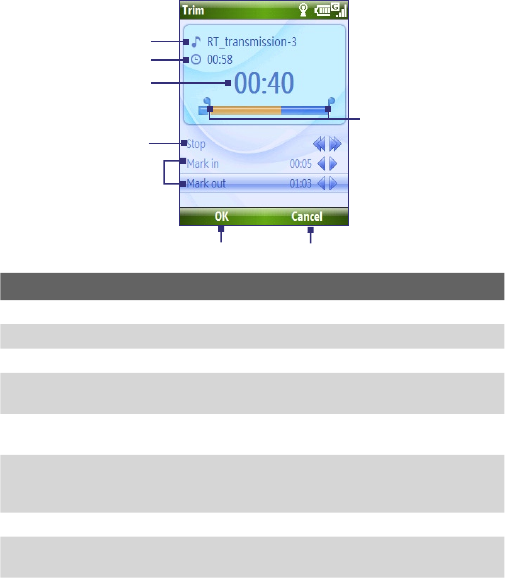
150 Experiencing Multimedia
MP3 Trimmer
Use MP3 Trimmer to trim MP3 files. You can choose to save it as a new file or
set it as a ring tone.
1
5
4
6
2
3
8
7
This control Does this
1Title Shows the name for the song.
2Duration Shows the length of the song after trimming.
3Time Shows the playback time when the song is played.
4Play/Stop Press CENTER OK to toggle between playing and
stopping playback.
5Mark in/
Mark out
Allows precise marking of the start and end times of the
song that will be used for the file.
6Mark in/Mark
out points
Shows the current mark in (start) and mark out (end)
points of the song. The song will be trimmed based on
these points.
7OK Click to confirm trimming the file.
8Cancel Click to exit MP3 Trimmer without trimming
the file.
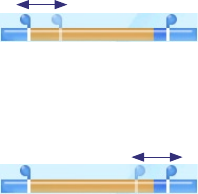
Experiencing Multimedia 151
To trim the MP3 file
1. In the Trim screen, use the NAVIGATION CONTROL to select Mark in.
2. Use NAVIGATION left/right to set the Mark in point. After you set the
Mark in point, the song will play back starting from the Mark in point.
Use NAVIGATION left/right to adjust the Mark in point if needed.
3. Use the NAVIGATION CONTROL to select Mark out and then use
NAVIGATION left/right to set the Mark out point. After you set the
Mark out point, the song will play back starting from 5 seconds before
the Mark out point. Use NAVIGATION left/right to adjust the Mark out
point if needed.
4. Use the NAVIGATION CONTROL to select Play. Press CENTER OK to
play back the trimmed song. While playing, you can use NAVIGATION
left/right to go backward or forward through a song.
5. Click Menu and select to whether set the file as the default ring tone,
save the file to the ring tone folder, or save it using another file name.
152 Experiencing Multimedia
9.5 Midlet Manager
The MIDlet Manager allows you to download Java-based applications, such
as games and tools that are specifically designed for mobile devices.
To install MIDlets from the Internet
1. On the Home screen, click Start > MIDlet Manager.
2. Click Menu > Install > Browse to open Internet Explorer Mobile.
3. Locate the MIDlet/MIDlet suite while connected to the Internet.
4. Select the MIDlet/MIDlet suite to download.
5. To start installing the MIDlet/MIDlet suite, click Yes.
6. Click Done to confirm the installation.
Notes
• You can cancel the installation at any time.
• Downloaded MIDlets will be automatically saved in the My Documents
folder.
To install MIDlets from a PC
You can install the MIDlets/MIDlet suites on your phone from a PC using the
USB sync cable or Bluetooth. You can copy the MIDlet file(s) from a PC to
any of the following temporary folders on your phone from where MIDlet
Manager can install them.
• Device memory: ../Smartphone/My Documents/My MIDlets
• Storage card: ../Smartphone/Storage Card
Note If the My MIDlets folder does not exist in My Documents, you can create
one with the same folder name. However, a folder named Storage Card
automatically appears after you insert a storage card into your phone.
Experiencing Multimedia 153
To install MIDlets from a local folder
1. On the Home screen, click Start > MIDlet Manager.
2. Click Menu > Install > Local to install the MIDlets currently saved in
the My MIDlets folder.
3. Select the MIDlet/MIDlet suite from the list using the NAVIGATION
CONTROL and press CENTER OK.
4. Click Yes to install.
To run MIDlets on your phone
1. On the Home screen, click Start > MIDlet Manager.
2. Select a MIDlet from the list using the NAVIGATION CONTROL.
3. Press CENTER OK to run the MIDlet.
Manage MIDlets
You can organize the MIDlets into groups and define custom groups. You
can also change the default display settings for a MIDlet.
To customize the display settings
1. On the Home screen, click Start > MIDlet Manager.
2. Click Menu > Settings.
3. On the Settings screen, select Display Options using the NAVIGATION
CONTROL and press CENTER OK.
4. In View Options, choose to display the MIDlets either in groups or all
at once.
5. In Sort Options, choose to sort by Name or by Size and click Done.
To uninstall a MIDlet
Before you uninstall a MIDlet/MIDlet suite, make sure that it is not running.
1. On the Java Apps screen, select the MIDlet/MIDlet suite using the
NAVIGATION CONTROL.
2. Click Menu > Manage > Uninstall.
3. Click OK to confirm.
Note You cannot uninstall a single MIDlet from a MIDlet suite; you must uninstall
the complete MIDlet suite.
154 Experiencing Multimedia
Appendix
A.1 Regulatory Notices
A.2 Specifications
156 Appendix
A.1 Regulatory Notices
Regulatory Agency Identifications
For regulatory identification purposes, your product is assigned a model
number of VOX0101. FCC ID: NM8VX.
To ensure continued reliable and safe operation of your device, use only the
accessories listed below with your VOX0101.
The Battery Pack has been assigned a model number of LIBR160.
This product is intended for use with a certified Class 2 Limited Power
Source, rated 5 Volts DC, maximum 1 Amp power supply unit.
European Union Notice
Products with CE marking comply with the R&TTE Directive (99/5/EC), the
EMC Directive (89/336/EEC) and the Low Voltage Directive (73/23/EEC)
issued by the Commission of the European Community.
Compliance with these directives implies conformity to the following
European Norms:
• EN 60950-1 (IEC 60950-1) – Safety of InformationTechnology
Equipment.
• ETSI EN 300 328 Electromagnetic compatibility and Radio spectrum
Matters (ERM); Wideband Transmission systems; data transmission
equipment operating in the 2.4GHz ISM band and using spread
spectrum modulation techniques.
• ETSI EN 301 511 – Global System for Mobile communications (GSM);
Harmonized standard for mobile stations in the GSM 900 and DCS
1800 bands covering essential requirements under article 3.2 of the
R&TTE directive (1999/5/EC).
• ETSI EN 301 489-1 Electromagnetic compatibility and Radio spectrum
Matters (ERM); ElectroMagnetic Compatibility (EMC) standard
for radio equipment and services; Part 1: Common technical
requirements.
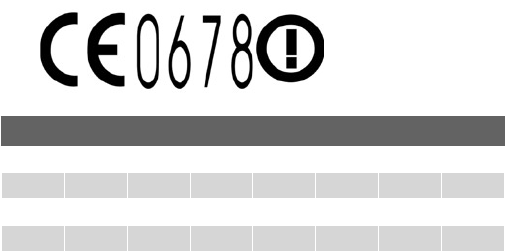
Appendix 157
• ETSI EN 301 489-7 – Electromagnetic compatibility and Radio
spectrum Matters (ERM); ElectroMagnetic Compatibility (EMC) for
radio equipment and services; Part 7: Specific conditions for mobile
and portable radio and ancillary equipment of digital cellular radio
telecommunications systems (GSM and DCS).
• ETSI EN 301 489-17 Electromagnetic compatibility and Radio
spectrum Matters (ERM); ElectroMagnetic Compatibility (EMC)
standard for radio equipment and services; Part 17: Specific
conditions for 2.4GHz wideband transmission systems.
• EN 50360 - 2001 – Product standard to demonstrate the compliance
of mobile phones with the basic restrictions related to human
exposure to electromagnetic fields (300 MHz ~ 3 GHz).
This equipment may be operated in:
AT BE BG CH CY CZ DE DK
EE ES FI FR GB GR HU IE
IT IS LI LT LU LV MT NL
NO PL PT RO SE SI SK TR
158 Appendix
Federal Communications Commission Notice
This device complies with part 15 of the FCC Rules. Operation is subject
to the following two conditions: (1) This device may not cause harmful
interference, and (2) this device must accept any interference received,
including interference that may cause undesired operation.
This equipment has been tested and found to comply with the limits for a
Class B digital device, pursuant to Part 15 of the FCC Rules. These limits are
designed to provide reasonable protection against harmful interference in
a residential installation. This equipment generates, uses, and can radiate
radio frequency energy and, if not installed and used in accordance with
the instructions, may cause harmful interference to radio communications.
However, there is no guarantee that interference will not occur in a
particular installation. If this equipment does cause harmful interference to
radio or TV reception, which can be determined by turning the equipment
on and off, the user is encouraged to try to correct the interference by one
or more of the following measures:
• Reorient or relocate the receiving antenna.
• Increase the separation between the equipment and receiver.
• Connect the equipment into an outlet on a circuit different from that
to which the receiver is connected.
• Consult the dealer or an experienced radio or television technician for
help.
• The FCC requires the user to be notified that any changes or
modifications made to the device that are not expressly approved
by High Tech Computer Corporation may void the user’s authority to
operate the equipment.
Safety precautions for RF exposure
Use only original manufacturer-approved accessories, or accessories that do
not contain any metal
Use of non-original manufacturer-approved accessories may violate your
local RF exposure guidelines and should be avoided.
For body worn operation, this phone has been tested and meets the FCC RF
exposure guidelines when used with the accessories supplied or designated
for this product. Use of other accessories may not ensure compliance with
FCC RF exposure guidelines.
Appendix 159
The exposure standard for wireless mobile phones employs a unit of
measurement known as the Specific Absorption Rate, or SAR.
The standard incorporates a substantial margin of safety to give
additional protection for the public and to account for any variations
in usage. Normal conditions only ensure the radiative performance
and safety of the interference. As with other mobile radio transmitting
equipment, users are advised that for satisfactory operation of the
equipment and for the safety of personnel, it is recommended that no
part of the human body be allowed to come too close to the antenna
during operation of the equipment.
SAR Information
• CE: 0.803 W/kg@10g (Head)
• FCC: 1.480 W/kg@1g (Body)
Heed service markings
Except as explained elsewhere in the Operating or Service documentation,
do not service any product yourself. Service needed on components inside
these compartments should be done by an authorized service technician or
provider.
Damage requiring service
Unplug the product from the electrical outlet and refer servicing to an
authorized service technician or provider under the following conditions:
• Liquid has been spilled or an object has fallen into the product.
• The product has been exposed to rain or water.
• The product has been dropped or damaged.
• There are noticeable signs of overheating.
• The product does not operate normally when you follow the
operating instructions.
160 Appendix
Telecommunications & Internet Association (TIA) safety
information
Pacemakers
The Health Industry Manufacturers Association recommends that a
minimum separation of six inches be maintained between a handheld
wireless phone and a pacemaker to avoid potential interference with the
pacemaker. These recommendations are consistent with the independent
research by and recommendations of Wireless Technology Research.
Persons with pacemakers:
• Should ALWAYS keep the phone more than six inches from their
pacemaker when the phone is turned ON.
• Should not carry the phone in a breast pocket.
• Should use the ear opposite the pacemaker to minimize the potential
for interference. If you have any reason to suspect that interference is
taking place, turn your phone OFF immediately.
Hearing Aids
Some digital wireless phones may interfere with some hearing aids. In the
event of such interference, you may want to consult your service provider,
or call the customer service line to discuss alternatives.
Other Medical Devices
If you use any other personal medical device, consult the manufacturer
of your device to determine if they are adequately shielded from external
RF energy. Your physician may be able to assist you in obtaining this
information.
Turn your phone OFF in health care facilities when any regulations posted
in these areas instruct you to do so. Hospitals or health care facilities may
be using equipment that could be sensitive to external RF energy.
Other tips and cautions
• Avoid using your phone near metal structures (for example, the steel
frame of a building).
• Avoid using your phone near strong electromagnetic sources, such as
microwave ovens, sound speakers, TV and radio.
• Avoid using your phone after a dramatic change in temperature.

Appendix 161
WEEE Notice
The Directive on Waste Electrical and Electronic Equipment (WEEE), which
entered into force as European law on 13th February 2003, resulted in a
major change in the treatment of electrical equipment at end-of-life.
The purpose of this Directive is, as a first priority, the prevention of WEEE,
and in addition, to promote the reuse, recycling and other forms of recovery
of such wastes so as to reduce disposal.
The WEEE logo on the product or on its box indicates that this product
must not be disposed of or dumped with your other household waste. You
are liable to dispose of all your electronic or electrical waste equipment
by relocating over to the specified collection point for recycling of such
hazardous waste. Isolated collection and proper recovery of your electronic
and electrical waste equipment at the time of disposal will allow us to help
conserving natural resources. Moreover, proper recycling of the electronic
and electrical waste equipment will ensure safety of human health and
environment. For more information about electronic and electrical waste
equipment disposal, recovery, and collection points, please contact your
local city centre, household waste disposal service, shop from where you
purchased the equipment, or manufacturer of the equipment.
RoHS Compliance
This product is in compliance with Directive 2002/95/EC of the European
Parliament and of the Council of 27 January 2003, on the restriction of the
use of certain hazardous substances in electrical and electronic equipment
(RoHS) and its amendments.

162 Appendix
A.2 Specifications
System information
Processor/Chipset • TI's OMAPTM 850 201 MHz
Memory • ROM-Nand Flash: 128 MB (Standard)
• RAM: 64 MB DDR
Figures are the total ROM and RAM memory available for use
and storage. Since the memory is shared by the Operating
System, applications, and data, the actual available memory is
less than what is written.
Operating system Microsoft® Windows Mobile® 6 Standard
Display
Type 2.4” Transmissive LCD with white LED back light
Resolution 320 x 240 dots resolution at 65K Colors (Landscape
view)
Orientation Portrait and Landscape (Keyboard open)
GSM/GPRS/EDGE Quad-band module
GSM 850 824 ~ 849, 869 ~ 894 MHz
GSM 900 880 ~ 915, 925 ~ 960 MHz
GSM 1800 1710 ~ 1785, 1805 ~ 1880 MHz
GSM 1900 1850 ~ 1910, 1930 ~ 1990 MHz
Camera module
Type 2 Megapixels CMOS
Resolution • UXGA: 1200 x 1600
• SXGA: 960 x 1024
• VGA: 480 x 640
• QVGA: 240 x 320
• QQVGA: 120 x160

Appendix 163
Connection
I/O port HTC ExtUSB™ : an 11-pin mini-USB and audio jack in
one
(ExtUSB is a proprietary connection interface that is
trademarked by HTC)
Bluetooth V 2.0 without EDR, Class 2 transmit power
Wi-Fi IEEE 802.11b/g compliant, Internal WLAN antenna
Audio
Microphone/speaker
Built-in microphone and loud speaker (for hands-free
support)
Headphone AAC/AMR/WMA/WAV/MP3 codec
Physical
Dimension 101.5 mm(L) x 50 mm(W) x 18.6 mm(T)
Weight 140g with battery pack
Controls and lights
Navigation 5-way navigation pad/Center OK button
Buttons • Power on/off (left)
• Left and RIght Softkeys
• Home screen
• Back to previous screen
• Talk (start call/answer call)
• End call/Lock keypad
• 36 key QWERTY keyboard
• 12 button keypad
• Volume buttons
• Camera button
• Voice Recognition/Voice Notes button

164 Appendix
Controls and lights
Lights • Event notification
• Charge status
• GSM/GPRS signals
• Bluetooth/Wi-Fi connection
Expansion slot
microSD slot microSD memory card
Power supply
Battery Li-Ion Polymer 1050 mAh removable, rechargeable
battery
Talk time Up to 7 hours
Standby Up to 175 hours
AC adapter • AC input/frequency: 100 ~ 240 AC, 50/60Hz
• DC output: 5V and 1A
Index
166 Index
A
Accessibility settings
- confirmation time out 59
- in-call alert volume 59
- multipress time out 59
- system font size 59
ActiveSync 50
- overview 25
- synchronize 51, 95
Add and remove programs 60
Add attachment to message 89
Adobe Reader 25, 151
Alarm 58
Alarm settings 57
Alerts 57
Answer/end call 41
Attachments 90
Audio Manager 25, 137
B
Back up files 62
Battery
- battery information 33
- battery management 59
- low battery 34
Beam
- via Bluetooth 118
Bluetooth
- beaming 118
- Bluetooth modem 120
- hands-free headset 116
- modes 114
- overview 114
- partnerships 115
- stereo headset 116
- synchronize 53
- visible 114
Bluetooth Explorer 25, 119
Browsing the Web 112
C
Calculator 26
Calendar 26, 73
Call History 26
Camera 126
- icons and indicators 127
- overview 26
- zoom 129
Camera settings 129
Capture formats 127
Capture modes 126
Check battery power 33
ClearVue Document 26, 150
ClearVue Office 148
ClearVue Presentation 26, 148
ClearVue Worksheet 26, 150
Clear Storage 26
Close running programs 61
Comm Manager 26, 106
Company Directory 101
Compose
- MMS message 84
Compose messages 88
Conference call 42
Confirmation time out 59
Connecting to Wi-Fi Network 107
Connect phone to Internet
- Dial-up 110
- Wi-Fi 107
Connect phone to private network
111
Index 167
Contacts 26, 68
- Beam contact information 70
- Call a contact 69
- Create a new contact 68
- Find a contact 69
- Send contact information via a text
message 70
- Send contact information via MMS
70
- View and edit a contact 69
Contacts picture (capture mode) 126
Copy
- contacts to SIM card 71
- files between phone and PC 62
- media files from PC to phone 134
- pictures and videos 130
- SIM contacts to phone 71
- sound file to phone 58
Currency setting 56
Customize Home screen 56
D
Date setting 56
Device lock 65
Dial-up connection 110
Digitally sign messages 102, 103
Digital Rights Management (DRM) 133
Digital signature
- verify 103
Direct Push 95
E
E-mail 88
- Outlook 86
- POP3/IMAP4 87
- security 102
Emergency call 43
Encrypt messages 102, 103
Enter text and numbers 29
Error reporting 60
Event notification 57
Exchange Server
- schedule synchronization 95
Exclude e-mail address when replying
to all 92
F
Fetch Mail 97
File Explorer 26, 62
Filter e-mail 89
Find contact
- online 101
Flag your messages 98
Flight mode 106
Font size (display) 59
Forward message 90
G
Games 26
GPRS 109
H
Home screen
- change background 56
- customize 56
- overview 24, 56
I
IMAP4 87
In-call alert volume 59
168 Index
Insert a long pause in dialing sequence
44
Insert pause in dialing sequence 44
Insert SIM Card 22
Install
- Microsoft ActiveSync 50
- Microsoft Windows Mobile Device
Center 49
Install microSD Card 23
Install MIDlets
- from Internet 144
- from PC 144
- locally 145
International call 43
Internet 107
Internet Explorer Mobile 26, 112
Internet Sharing 26, 113
L
Language/locale setting 56
LED indicator lights 20
Licensed and protected media 133
Lock
- keyboard 64
- phone 65
M
Make call
- from Call History 40
- from Contacts 40
- from Home Screen 39
- from Speed Dial 41
Managing Meeting Requests 99
Memory 61
Messaging 26, 80
- Outlook e-mail 86
Messenger 27
microSD Card 23
Microsoft ActiveSync 50
Microsoft Windows Mobile Device
Center 49
MIDlet Manager 27
MMS
- access MMS 82
- create and send 84
- MMS settings 82
MMS video (capture mode) 126
Modem
- Bluetooth modem 120
- USB modem 113
MP3 Trimmer 142
Multipress mode 29
Music Player 139
Mute call 43
N
Number format 56
Numeric mode 30
O
Operating system version 60
Out-of-office 99
Outlook e-mail 86
Owner information 58
P
Parts and accessories 16
Pause in dialing sequence 44
PDF 151
Personal information 58
Phone program 37
Index 169
Phone specification 60
Photo (capture mode) 126
Pictures & Videos 27, 130
Picture theme (capture mode) 126
PIN 38, 64
Playlists (Audio Manager)
140
Play media 136
POP3 87
Power management 59
Profile 57
Programs 25
- ActiveSync 25
- Adobe Reader 25
- Audio Manager 25, 137
- Bluetooth Explorer 25
- Calculator 26
- Calendar 26, 73
- Call History 26
- Camera 26
- ClearVue Document 26, 150
- ClearVue Presentation 26, 148
- ClearVue Worksheet 26, 150
- Clear Storage 26
- Comm Manager 26
- Contacts 26, 68
- File Explorer 62
- Games 26
- Internet Explorer 26
- Internet Sharing 26, 113
- Messaging 26, 80
- Messenger 27
- MIDlet Manager 27
- Phone 37
- Pictures & Videos 27, 130
- Quick Notes 27
- SAPSettings 27
- SIM Manager 27, 71
- Speed Dial 27, 152
- Tasks 27, 76
- Task Manager 27, 61
- Video Recorder 27
- Voice Notes 27, 77
- Windows Live 27
- Windows Live Mobile 121
- Windows Media Player Mobile 27,
132
SIM Manager 27
Put call on hold 42
Q
Quick List 28
Quick Notes 27, 77
QWERTY Keyboard 31
QWERTY keyboard 29
R
Receive
- call 41
- MMS message 85
Regional settings 56
Reply
- MMS message 85
Reply message 90, 92
Reset phone 66
Restart phone 65
Review screen 129
Ring tone 38, 78, 141
Run MIDlets 145
170 Index
S
SAPSettings 27, 45
Search for e-mails on the Exchange
Server 97
Secure/Multipurpose Internet Mail
Extension (S/MIME) 102
Securing Wi-Fi Connection 109
Send
- email/SMS message 88
- MMS message 84
Send and download e-mails 91
Send appointments 74
Send messages 88
Settings 27
Setting Up E-mail Accounts 86
Set music as ring tone 141
Set up ActiveSync on PC 50
Set up Home screen 56
SharePoint documents 99
Share contact information 70
SIM Access Profile (SAP) 45
SIM Manager
- copy contacts to SIM card 71
- copy SIM contacts to phone 71
- create SIM contact 71
Sounds 57
Speakerphone 43
Speed Dial 27, 41, 152
Sports (capture mode) 126
Start menu 28
Stop programs 61
Synchronize
- ActiveSync 51
- change information types 51
- music and video 54
- schedule synchronization with
Exchange Server 95
- via Bluetooth 53
- Windows Media Player 54
System font size 59
T
T9 mode 30
Tasks 27, 76
Task Manager 27, 61
Time setting 56
Turning On and Off the Phone 24
V
Verify digital signature 103
Video (capture mode) 126
Video Recorder 27
Viewing media files 130
View and reply to MMS messages 85
View your appointments 74
Visible (Bluetooth) 114
Voice Notes 27, 77
Voice Tag 153
Voice tag
- create voice tag for phone number,
e-mail address, or URL in
Contacts 153
- create voice tag for program 154
- edit, delete, and play voice tags
154
W
Web browser 112
Wi-Fi 107
Windows Live 27
Index 171
Windows Live Mobile 121
Windows Media Player
- file formats 132
- menus 133
- overview 27
- troubleshooting 136
Windows Mobile Device Center 49
Windows Mobile software version 60
Z
Zoom 128